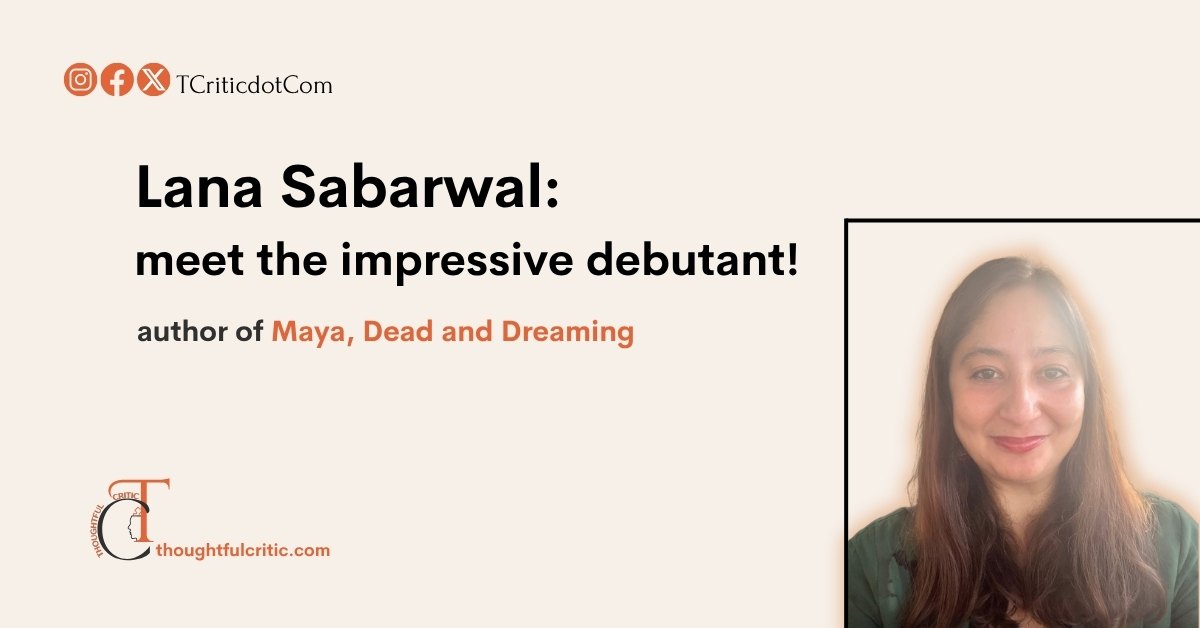Lana Sabarwal’s Maya, Dead and Dreaming is not just a mystery novel; it is a meticulously constructed psychological labyrinth. Did I sound too mystic? Let me simplify. This story lingers in the mind like an unsolved riddle long after the final revelation. What makes the book remarkable is not just its tightly wound plot or its richly drawn characters, but the fact that it was written by an economist-a professional accustomed to dealing in data, policy, and empirical analysis, rather than the ambiguities of human motive and the shadowy corners of small-town secrets. Yet, Sabarwal’s background in economics and international development does not hinder her storytelling—it enhances it. Her ability to dissect systems, to understand how power and information flow through communities, and to recognise how people obscure truth for self-preservation all feed into the novel’s intricate construction. The result is a debut that feels both classical in its mystery foundations and strikingly modern in its psychological depth.
From the very first page, Sabarwal establishes an atmosphere of quiet unease. The novel opens in Shogie, Washington, a town described as “utterly incapable of hiding a murder, yet it did.” This contradiction, like an illusion of transparency in a place where darkness festers beneath the surface, sets the tone for the entire narrative. When Munna, the protagonist, receives an anonymous letter titled Why Maya Had to Die, the past, long buried, comes rushing back with the force of a flood. The letter does not merely suggest that Maya Hickman’s death fourteen years earlier was not an accident; it declares it outright, with a chilling addendum: And soon death will come again. Sabarwal’s choice to frame the mystery through an anonymous accusation is a stroke of narrative genius, immediately establishing stakes and paranoia. Unlike traditional detective stories where the investigator seeks answers from the outside, Munna is already entangled in Shogie’s social fabric, making her investigation feel personal, urgent, and dangerous.

Sabarwal’s training as an economist is evident in the way she structures the novel’s revelations. There is a precision to the unfolding of clues, a methodical layering of information that mirrors the careful assembly of a research paper. Each character interviewed—Maya’s sister Emma, her domineering father Josh, her fragile yet manipulative mother Shelly, her conflicted brother Ian, her secretive aunt Tracy—provides a piece of the puzzle, but never the whole picture. The reader, like Munna, must sift through contradictions, half-truths, and outright lies. Sabarwal understands that the most compelling mysteries are not just about what happened, but why people choose to remember events in specific ways. This is where her expertise in gender and social dynamics shines. The Hickman family is not just hiding a crime; they are performing a version of themselves for the town, for each other, and even for themselves. Josh, the patriarch, wields both financial and social power, controlling the narrative. Shelly, the grieving mother, plays the role of the helpless widow so convincingly that even those closest to her are fooled—until Karenina, the sharp-eyed psychoanalyst, begins to peel back the layers.
Karenina is one of Sabarwal’s most fascinating creations, a character who feels like an homage to Agatha Christie’s brilliant detectives while also carving out her own space. She is not a traditional sleuth; she is an observer of human behaviour, a woman who understands that psychology is often the key to unlocking a mystery. Her deductions about Shelly—that her apparent fragility is a performance, that she is, in fact, the true architect of the family’s façade—are delivered with the cool logic of a clinician. Yet, they carry the weight of devastating truth. Sabarwal’s background in analysing systems of power and behaviour informs Karenina’s methods. There is no reliance on flashy breakthroughs or convenient coincidences; every revelation is earned through scrutiny of human inconsistency.
The novel’s suspense is built not just on the question of who killed Maya, but on the slow unravelling of why her death was covered up, and why, after fourteen years, someone is now willing to risk exposing it. Sabarwal plays with time masterfully, weaving between 1952, when Munna receives the letter, and 1938, the night of Maya’s death. The past is not presented in linear flashbacks but in fragments, like scattered evidence, forcing the reader to piece together the sequence of events just as the characters must. This structural choice creates a sense of instability, a feeling that the truth is always just out of reach. Even the setting, the creek where Maya drowned, the Hickman house with its secrets, Linden Law’s estate, and The Ranch, becomes a character in itself, a silent witness to the lies and betrayals that have festered over the years.
What makes Maya, Dead and Dreaming stand out among contemporary mysteries is its refusal to simplify its characters into heroes or villains. Even Shelly, whose actions are monstrous, is rendered with a tragic complexity. Her confession at the end is not just the climax of the mystery; it is the culmination of a lifetime of suppressed desire, resentment, and calculated survival. Sabarwal’s understanding of how women navigate oppressive systems—whether in 1950s small-town America or in the global gender disparities she studies in her professional work—adds a layer of depth to Shelly’s character. She is a woman who has learned to weaponise her own perceived weakness, a theme that resonates far beyond the confines of the novel.
Sabarwal’s prose is another unexpected strength. One might assume that an economist’s writing would lean toward the clinical, but her style is lush and evocative, particularly in her descriptions of Munna’s haunting dreams. The recurring image of Maya as a spectre, sometimes a grotesque witch, sometimes a drowned girl reaching from the creek, blurs the line between memory and nightmare, between the supernatural and the psychological. These sequences are not just atmospheric flourishes; they reflect Munna’s growing unease, her fear that uncovering the truth might cost her more than she realises.
In the end, Maya, Dead and Dreaming is more than a satisfying whodunit. It is a meditation on how stories are constructed, how gossip can be both weapon and shield, and how people rewrite their histories to survive. That Sabarwal, an economist by trade, has crafted such a nuanced, suspenseful, and emotionally resonant novel is a testament to her skill as a storyteller. Her ability to translate the analytical rigour of her profession into the realm of fiction results in a mystery that is as intellectually engaging as it is emotionally gripping. For a debut novelist, she displays a remarkable command of pacing, character, and atmosphere—elements that many seasoned writers struggle to balance.
Perhaps the highest praise one can give Maya, Dead and Dreaming is that it feels like the work of a writer who has been honing her craft for decades, not a first-time author. And yet, Sabarwal’s fresh perspective, her economist’s eye for hidden systems, her global understanding of gender and power, bring something entirely new to the genre. In an era where mystery novels often rely on shock value or formulaic twists, hers is a story that lingers, that demands to be dissected and discussed. It is a novel that proves the best suspense does not come from cheap surprises, but from the slow, inexorable revelation of human nature—and Sabarwal, against all expectations, has delivered a masterclass in precisely that.
Liked the premise? You can get a copy of the novel from Amazon right now – click here to get it now.
Ashish for Thoughtful Critic
…




